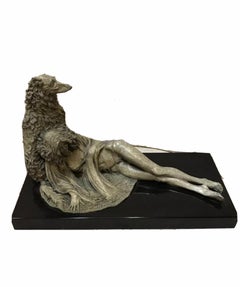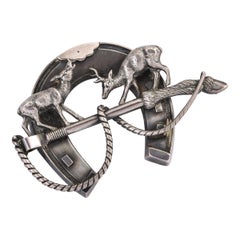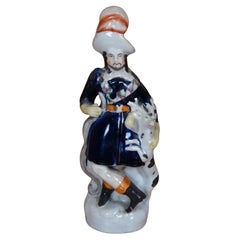Scottish Deer
to
12
62
25
35
26
26
17
13
9
8
8
6
6
4
3
2
2
2
2
1
1
1
1
1
1
2
2
2
1
1
Sort By
LADY AND SCOTTISH DOG
Located in Pasadena, CA
Magnificent beautiful masterpiece bronze sculpture of lady with the Scottish Deer Hunter dog bronze
Category
2010s American Modern Figurative Sculptures
Materials
Bronze
Young Deer in Summer Scottish Highland Glen by Pool of Water
Located in Cirencester, Gloucestershire
Artist/ School: Scottish School, 20th century
Title: Young deer roaming in a Scottish summers glen
Category
20th Century Victorian Landscape Paintings
Materials
Oil
$1,162 Sale Price
30% Off
H 17.75 in W 20.25 in
Victorian Scottish Sterling Horseshoe Brooch with Three Dimensional Deer
Located in Stamford, CT
A Scottish Horseshoe brooch in sterling with two sculpted three dimensional deer on top of a deer
Category
Antique Mid-19th Century Scottish Victorian Brooches
Materials
Sterling Silver
Deer & Eagle Winter Snow Scottish Landscape Signed British Painting
Located in Cirencester, Gloucestershire
Eagle & Deer
by Ben George Powell, British contemporary artist
signed and dated 2014
acrylic on
Category
21st Century and Contemporary Modern Landscape Paintings
Materials
Acrylic
$1,177 Sale Price
30% Off
H 20 in W 24 in
Antique Staffordshire Scottish Highlander Huntsman Bow Deer Stag Figurine 9"
Located in Dayton, OH
Antique 19th century Staffordshire porcelain flatback figurine depicting a Scottish huntsman in a
Category
Antique 19th Century Victorian Figurative Sculptures
Materials
Porcelain
$188 Sale Price
20% Off
H 9 in W 3.5 in D 2.75 in
Bronze Stag and Deer Statues Pair Scottish Highland Garden Castings
Located in Potters Bar, GB
Gorgeous bronze duo of a stag and a deer
Lifesize set of Scottish Highland creatures
Wonderful
Category
Vintage 1980s Statues
Materials
Bronze
Antique Staffordshire Scottish Highlander Horse Deer Stag Hunt Table Lamp 24"
Located in Dayton, OH
two light table lamp, depicting a Scottish Highlander / hunter on horseback with a deer / stag draped
Category
Antique 19th Century Victorian Table Lamps
Materials
Hardwood, Porcelain
$480 Sale Price
20% Off
H 16 in W 10.5 in D 5 in
Large Victorian Scottish Oil Painting Highland Family Stag & Deer Loch Sunrise
Located in Cirencester, Gloucestershire
Sunrise in the Scottish Highlands
by Clarence Roe (1850-1920)
signed & dated 1880's
oil painting on
Category
Late 19th Century Victorian Landscape Paintings
Materials
Oil
$1,696 Sale Price
30% Off
H 28 in W 40 in
Stag & Deer Grazing In The Frozen Scottish Highlands, 19th Century ROBERT ROE
Located in Blackwater, GB
Stag & Deer Grazing In The Frozen Scottish Highlands, 19th Century
by ROBERT HENRY ROE (BRITISH
Category
19th Century Animal Paintings
Materials
Canvas, Oil
Huge Victorian Scottish Oil Painting Highland Loch Landscape with Deer Sunset
By Clarence Roe
Located in Cirencester, Gloucestershire
Sunset in the Highlands
by Clarence Henry Roe (British 1850-1909)
signed oil on canvas, framed
framed: 27 x 37 inches
painting: 20 x 30 inches
provenance: private collection, England...
Category
Late 19th Century Victorian Landscape Paintings
Materials
Oil
$2,403 Sale Price
30% Off
H 27 in W 37 in
Stags Rutting in Scottish Highland Landscape Family of Deer Signed Oil Painting
Located in Cirencester, Gloucestershire
Artist/ School: Ralston Gudgeon (Scottish 1910-1984)
Born Ayr, painter of birds and animals
Category
Mid-20th Century Victorian Landscape Paintings
Materials
Oil
$1,270 Sale Price
30% Off
H 27.5 in W 45 in
Highland Stag Family of Deer Glen Dhu Sutherland Scotland signed British oil
Located in Cirencester, Gloucestershire
The Highland Family
by Madeline Selfe (British 1910-2005)
signed oil on canvas, framed
framed: 24 x 27 inches
canvas: 19.75 x 23.5 inches
provenance: private collection, -UK
The pai...
Category
20th Century Impressionist Landscape Paintings
Materials
Oil, Canvas
$2,354 Sale Price
30% Off
H 24 in W 27 in
Hart of Mine, Deer Art, Stag Art, Contemporary Animal Art, Bright Scottish Art
By Sophie Harden
Located in Deddington, GB
Hart of mine is an original oil painting by Sophie Harden. Contrasted blues and fawns on a coral background gives this piece a huge pop of colour and sense of movement the stag stand...
Category
2010s Contemporary Animal Paintings
Materials
Oil, Board
$770
H 17.33 in W 21.26 in D 1.58 in
Victorian Stag Taxidermy Scottish Highlands Monarch Of The Glenn
Located in Potters Bar, GB
A Victorian taxidermy study of a Scottish highland deer
This stag is dated to circa 1860
And would
Category
Antique 1860s Victorian Statues
Materials
Wood
$19,618
H 78.7 in W 17.7 in D 62.7 in
The Monarch Of The Glen, 19th Century - Sottish Highland Stag Deer & Fawn
Located in Blackwater, GB
Scottish view of a Stag, Deer and Fawn, oil on canvas. Excellent quality and condition circa 1870 Highland
Category
19th Century Animal Paintings
Materials
Canvas, Oil
19th Century "Caledonia" Tray by Adams
By Adams
Located in High Point, NC
this pattern. The pattern is vistas of the Scottish Highlands, with a Scottish hunter stalking deer
Category
Antique Early 19th Century English Victorian Platters and Serveware
Materials
Ceramic
A Belle Époque gold buck stick pin
Located in London, GB
Britain: Scottish red and roe deer are native and have lived in the isles for thousands of years. Fallow
Category
21st Century and Contemporary French Belle Époque Brooches
Materials
18k Gold, Yellow Gold
The Eclectic Set of Harris Tweed Wrapped Scottish Deer Antlers.
By RhubarbLondon
Located in London, GB
Impressive set of Scottish deer antlers painstakingly hand-sewn and wrapped in traditional Harris
Category
21st Century and Contemporary Scottish Wall-mounted Sculptures
Materials
Gold Leaf
$2,501
H 38.19 in W 45.28 in D 34.65 in
Scottish Red Deer Horn Armchair
Located in Bridgehampton, NY
Scottish red deer Horn armchair with wool tartan upholstery.
Category
21st Century and Contemporary European Armchairs
Anthony Redmile Scottish Stag Red Deer Antler Candlesticks
By J. Antony Redmile
Located in London, GB
A number of finishes available:
Metal work-nickel, antique brass, bronze, copper
Antler: natural, brown, bleached and painted in customers own choice.
Single light, three-light an...
Category
21st Century and Contemporary British Table Lamps
Materials
Brass, Nickel
$2,732 / item
H 29.53 in W 17.72 in D 19.69 in
Anthony Redmile Scottish Stag Red Deer Antler Candlesticks
By J. Antony Redmile
Located in London, GB
A number of finishes available:
Metal work - nickel, antique brass, bronze, copper
Antler: natural, brown, bleached and painted in customers own choice.
Single light, three light...
Category
21st Century and Contemporary British Table Lamps
Materials
Brass, Nickel
$2,732 / set
H 29.53 in W 17.72 in D 19.69 in
Large Bronze Stag, Scottish Highlands Deer Sculpture Stags, 20th Century
Located in London, GB
A large bronze stag, Scottish highlands deer sculpture stags, 20th century.
Wonderful bronze
Category
20th Century European Animal Sculptures
Materials
Bronze
$2,172
H 43 in W 16 in D 41 in
Anthony Redmile Scottish Red Deer Antler or Stag Horn Chandelier
By J. Antony Redmile
Located in London, GB
Anthony Redmile Scottish red deer antler/stag horn two-tier, twelve-light chandelier, made in the
Category
2010s British Chandeliers and Pendants
Materials
Antler
$11,560 / item
H 55.12 in W 47.25 in D 47.25 in
19th Scottish Inkwell
Located in Reggio Emilia, IT
Scottish inkwell made from a deer leg mounted in silver. Second half of the nineteenth century.
Category
Antique Mid-19th Century Desks and Writing Tables
Materials
Silver
The call of the stag
By Harold Frank Wallace
Located in Petworth, West Sussex
in his paintings of red deer and landscapes. During World War II he was the Deer Controller for
Category
20th Century Animal Drawings and Watercolors
Materials
Watercolor, Gouache
The grazing herd
By Harold Frank Wallace
Located in Petworth, West Sussex
his paintings of red deer and landscapes. During World War II he was the Deer Controller for Scotland
Category
20th Century Animal Drawings and Watercolors
Materials
Watercolor, Gouache
Pair of Vintage French Weathered Carved Stone Statuary Scottish Deer Hounds
Located in Dallas, TX
conjure a traditional style. Each dog weights 97 pounds.
The Scottish Deerhound, or simply the Deerhound
Category
Early 2000s French Animal Sculptures
Materials
Cast Stone
$2,950 / set
H 29.75 in W 10.5 in D 12 in
Pair of Red Deer Antlers, Skull Mount, Scotland, Cluny Castle 1989
Located in Oxfordshire, GB
, north-east Scotland.
The Red Deer (Cervus elaphus), or Red Stag, is one of the largest deer species
Category
Vintage 1970s Scottish Taxidermy
Materials
Antler, Wood
$630
H 25.99 in W 29.93 in L 25.99 in
Stag and Deer in a Scottish landscape
By Robert Cleminson
Located in Woodbury, CT
and Scotland and was famous for his highland Scottish sporting scenes.
This is a fine example of the
Category
1880s Victorian Animal Paintings
Materials
Oil
A Pair of Scottish Pottery Pearlware Plaques of Deer
Located in Downingtown, PA
Each molded in relief with a stag and doe sponged and painted in black, recumbent and standing upon a sponged green mound and beneath three floral sprays in rose, green and black ena...
Category
Antique 19th Century British Animal Sculptures
Deer Antler Chandelier
Located in New York, NY
naturally shed Scottish red deer antlers. Electrified.
Category
20th Century English Chandeliers and Pendants
DEER ANTLER CHANDELIER
Located in New York, NY
Charming small "Cottage" five-light chandelier made of naturally shed Scottish Red Deer antlers
Category
20th Century English Chandeliers and Pendants
Set of 6 Original Antique Prints of Deer, 1830s
Located in St Annes, Lancashire
Great set of deer and moose.
Ideal for decorating a ski lodge
Lithographs after the drawings
Category
Antique 1830s Scottish Country Prints
Materials
Paper
Scottish Mounted Taxidermy Stag, Early 20 Century
Located in London, GB
A large magnificent Scottish red deer stag taxidermy mounted hunting trophies, dating from the
Category
Antique Early 1900s Scottish Taxidermy
Materials
Oak
Scottish Mounted Taxidermy Stag, Mid-20th Century
Located in London, GB
A large magnificent Scottish red deer stag taxidermy mounted hunting trophy labelled verso "Killed
Category
Vintage 1950s Scottish Taxidermy
Materials
Other
Vintage Pair of Red Deer Antler Wall Lights, Mid 20th Century
Located in London, GB
This is a large fantastic pair of vintage Scottish one light wall lights made from naturally shed
Category
Vintage 1950s Scottish Wall Lights and Sconces
Materials
Antler
$910 / set
H 23.63 in W 15.75 in D 10.24 in
Vintage Set of Four Red Deer Antler Wall Lights, Mid 20th Century
Located in London, GB
This is a fantastic set of four vintage Scottish one light wall lights made from naturally shed red
Category
Vintage 1950s Scottish Wall Lights and Sconces
Materials
Antler, Faux Leather, Oak
$1,331 / set
H 15.75 in W 10.24 in D 9.06 in
1891 Scottish Highlands with Ducks Painting
Located in Chapel Hill, NC
Signed & dated 1891 oil painting of ducks flying over a lake in the Scottish highlands with a stag
Category
Antique 1890s Other Paintings
Materials
Paint
Pair of Antler Candlesticks
Located in New York, NY
Pair of deer antler candlesticks with small round brass bases. Made of naturally shed Scottish
Category
20th Century English Candle Holders
ANTLER CHANDELIER
Located in New York, NY
Magnificently sized two-tier chandelier made of naturally shed Scottish Red Deer antlers. Hand
Category
20th Century English Chandeliers and Pendants
Antler Side Table
Located in New York, NY
banding. All on Scottish red deer antler legs.
Category
20th Century English Side Tables
Materials
Brass
ANTLER CHAIR
Located in New York, NY
Unique antler chair designed with Fallow Deer antlers from Scotland. A work of art with naturally
Category
20th Century English Chairs
Materials
Wood, Antler, Leather
Custom-Made Two-Tier Antler Chandelier
Located in London, GB
This outstanding antler chandelier was custom designed and made from naturally shed large red deer
Category
2010s English Chandeliers and Pendants
Materials
Nickel
Custom-Made Two-Tier Antler Chandelier
Located in London, GB
This outstanding antler chandelier was custom designed and made from naturally shed large red deer
Category
2010s British Chandeliers and Pendants
Materials
Brass
Glass Panelled Antler Horn Lantern
Located in London, GB
deer in Scotland. The lantern features eight glass panels set in a mahogany frame and four candle
Category
2010s English Lanterns
Materials
Antler, Glass, Hardwood
The Fall Of The King, 19th Century by LOUIS HENRY WESTON KLINGENDER (1861-1950
Located in Blackwater, GB
Century Scottish Highland deer hunt scene, oil on canvas by Louis Klingender. Excellent quality and
Category
19th Century Animal Paintings
Materials
Canvas, Oil
21st Century Ornate Oval Dark Antler Horn Mirror
Located in London, GB
This marvelous and unique oval wall mirror is comprised of naturally shed large red deer from
Category
2010s British Wall Mirrors
Materials
Antler, Mirror
Pair of Original Design Antler Horn Armchairs
Located in London, GB
This unusual pair of Antler armchairs have been constructed from naturally shed red deer from
Category
2010s British Armchairs
Materials
Antler, Hide
Pair of White Washed Natural Antler Table Lamps
Located in London, GB
red deer antlers from Scotland. The antlers have a whitewash finish and are mounted onto a circular
Category
2010s English Table Lamps
Materials
Nickel
Artisan Designed Dark Antler Oval Mirror with a Crown Motif
Located in London, GB
This stunning and original design oval wall mirror is comprised of naturally shed large red deer
Category
2010s British Wall Mirrors
Materials
Antler, Hardwood
Large Scottish Highlands Landscape Oil Stag with Family of Deer Misty Glen
Located in Cirencester, Gloucestershire
Artist/ School: Scottish School, early 1900's
Title: The Highland Family
Medium: oil on canvas
Category
Early 20th Century Victorian Landscape Paintings
Materials
Oil, Canvas
$3,082
H 24 in W 36.5 in
Pair of Red Deer Antlers, Skull Mount, Scotland, Bincombe, Longstones, 1970
Located in Oxfordshire, GB
Red Deer Antlers, Bincombe - Longstones 1970.
A pair of 6 point red deer antlers with skull cap
Category
Vintage 1970s Scottish Wall-mounted Sculptures
Materials
Antler, Wood
$322
H 25.01 in W 18.12 in D 9.06 in
Vintage Scottish 8 Light Red Deer Antler Chandelier Mid 20th Century
Located in London, GB
This is a huge fantastic vintage Scottish eight light chandelier made from naturally shed red deer
Category
Vintage 1950s Scottish Chandeliers and Pendants
Materials
Antler
Scottish Stag in the Highlands of Scotland with its family of deer
By William Rogar
Located in Woodbury, CT
Fantastic Scottish highland scene of a Stag with his family in the highlands of Scotland
William
Category
1960s Victorian Animal Paintings
Deer in Scottish Misty Autumn Landscape Signed Oil Painting
By Robert Dyer
Located in Cirencester, Gloucestershire
moment in time, with two deer standing in the autumnal landscape, Scottish mists swirling behind them and
Category
Late 20th Century Realist Landscape Paintings
Materials
Oil
$2,101
H 25 in W 34 in D 1 in
Fine Mid Victorian Scottish Oil Painting Stag & Deer in Highland Landscape
Located in Cirencester, Gloucestershire
'A Highland Landscape'
Stag and Deer in Scottish Highlands
circle of Charles Landseer (British
Category
Mid-19th Century Victorian Animal Paintings
Materials
Oil
Red Deer in Scottish Highland Landscape Signed Original Oil Painting
By Leonard G. Stephens
Located in Cirencester, Gloucestershire
artist has captured the majesty of these beautiful deer amidst the glorious surroundings of their natural
Category
Late 20th Century Realist Animal Paintings
Materials
Oil
$1,751
H 21 in W 27.5 in D 1 in
Antique British Oil Painting Deer in the Scottish Highlands Loch Sunrise
Located in Cirencester, Gloucestershire
"Mist Rising in the Highlands"
Scottish Loch scene with deer
by Frank Hider (c. 1861–1933)
signed
Category
Late 19th Century Victorian Landscape Paintings
Materials
Oil, Canvas
- 1
Get Updated with New Arrivals
Save "Scottish Deer", and we’ll notify you when there are new listings in this category.
Scottish Deer For Sale on 1stDibs
An assortment of Scottish deer is available at 1stDibs. Frequently made of antler, bone and paper, all Scottish deer available were constructed with great care. Scottish deer have long been popular, with older editions for sale from the 19th Century and newer versions made as recently as the 21st Century. There are many kinds of Scottish deer to choose from, but at 1stDibs, Victorian Scottish deer are of considerable interest. Scottish deer have been a part of the life’s work for many furniture makers, but those produced by William Rogar, Robert Cleminson and Peter Coulthard are consistently popular.
How Much are Scottish Deer?
The average selling price for at 1stDibs is $2,168, while they’re typically $495 on the low end and $6,500 highest priced.







